Deborah Griscom Passmore
| Deborah Griscom Passmore | ||
|---|---|---|
 | ||
| Información personal | ||
| Nacimiento | 1840  Condado de Delaware (Estados Unidos)  | |
| Fallecimiento | 1911  Washington D.C. (Estados Unidos)  | |
| Nacionalidad | Estadounidense | |
| Educación | ||
| Educada en | ||
| Alumna de | Thomas Moran  | |
| Información profesional | ||
| Ocupación | Pintora, ilustradora botánica y profesor de arte  | |
| Empleador | Departamento de Agricultura de los Estados Unidos  | |
[editar datos en Wikidata] | ||
Deborah Griscom Passmore (Delaware, 17 de julio de 1840–3 de enero de 1911) fue una ilustradora botánica estadounidense, que se especializó en pinturas de frutas para el Departamento de Agricultura de los Estados Unidos (USDA). Su trabajo se conserva actualmente en la Pomological Watercolor Collection del USDA, está considerada la mejor entre los primeros artistas de la institución.[1] Passmmore dirigió a los artistas del USDA y se convirtió en la más prolífica del grupo, contribuyendo con una quinta parte de las 7500 pinturas de la Pomological Watercolor Collection.
Trayectoria
Deborah Griscom Passmore fue la quinta y última hija de Elizabeth K. Knight (1800 - 1845) maestra y predicadora de una rama ortodoxa de cuáqueros y de Everett Griscom Passmore (1787 - 1868) un agricultor. Passmore recibió los nombres de Deborah Griscom por su abuela paterna, quien era prima hermana de Betsy Ross. Su madre murió cuando aún era una niña y Passmore se educó en un internado cercano donde su madre había sido maestra antes de casarse. Luego se formó como artista en la Escuela de Diseño para Mujeres y en la Pennsylvania Academy of the Fine Arts.[2][3] Su prima, Deborah Passmore Gillingham (1820 - 1877) también fue artista botánica,[4] aunque era una aficionada y su trabajo no se publicó hasta hace poco.[5]
Passmore siguió su formación artística en Filadelfia y estudió arte en Europa durante un año. Allí, encontró inspiración en las ilustraciones botánicas de Marianne North en Real Jardín Botánico de Kew, Inglaterra, y cuando regresó a los Estados Unidos, comenzó a pintar las flores silvestres de América, así como lirios y otras flores.[6] Esperaba publicar estas acuarelas bajo el título Flores en el color del agua: Flores silvestres de América, pero nunca logró hacerlo y el manuscrito ahora se encuentra en las Colecciones especiales del USDA.[6] El arte de Passmore se caracterizó por el delineado de los dibujos con una precisión minuciosa y en ocasiones usó hasta cien lavados para obtener el efecto deseado. El conocido botánico Edward Lee Greene era un gran admirador de las pinturas de flores de Passmore.[2] También pintó cactus y algunas de sus acuarelas se imprimieron en la obra de 1919, titulada The Cactaceae que fue publicada por el Instituto Carnegie.
Passmore trabajó en Filadelfia como maestra durante varios años antes de mudarse a Washington D. C. por influencia de William Wilson Corcoran, fundador de la Galería de Arte Corcoran, quien quedó muy impresionado por su trabajo.[2][6] Corcoran murió antes de que Passmore pudiera obtener trabajo a través de esta conexión. Passmore comenzó a trabajar en 1892 como ilustradora en el Departamento de Agricultura de los Estados Unidos, en el momento en que las principales regiones productoras de fruta en los Estados Unidos estaban surgiendo, los agricultores trabajaron con el USDA para establecer huertos que les permitieran expandir su mercado. La fotografía aún no se usaba ampliamente como medio documental, por lo que el gobierno confió en artistas como Passmore, Amanda Newton, Elsie Lower, Ellen Isham Schutt y Royal Charles Steadman quienes realizaron dibujos técnicamente precisos para sus publicaciones.[1]
Passmore fue una de los más de 50 ilustradores botánicos contratados en este período, fue promovida rápidamente, siendo nombrada líder del equipo de artistas de la división de Pomología, el mismo año en que fue contratada. Una de sus primeras tareas para el USDA fue pintar exhibiciones para la Exposición Mundial Colombina de 1893, en Chicago, en la que también pudo exhibir algunas de sus propias pinturas.[7] Siguió trabajando para el USDA durante diecinueve años. Alan Fusonie, jefe de las Colecciones Especiales de la Biblioteca Nacional de Agricultura, en 1990 la consideró "la mejor ejemplo de calidad de los primeros ilustradores del USDA" y sus acuarelas de frutas en particular, un tesoro nacional.[1]: 301–02 En un libro sobre las raíces del ecofeminismo, Greta Gaard cita a Deborah Passmore junto con las artistas de naturaleza Lucy Say y Grace Albee como mujeres que ayudaron a "crear un clima y una tradición que pueden considerarse fundamentales para el ecofeminismo".[8]
La obra de Passmore para el USDA cubrió una amplia gama de frutas, incluidas manzanas, peras, ciruelas, duraznos, naranjas, caquis, fresas y grosellas, así como el níspero, kumquat y cereza de Surinam, menos comunes. Passmore fue extremadamente prolífica, produciendo más de 1500 acuarelas y dibujos terminados para el USDA, más de la mitad de los cuales fueron creados entre 1895 y 1902. Muchos de estos se pueden encontrar en los informes técnicos y publicaciones de la agencia. Además, entre 1901 y 1911, se publicó una selección de su trabajo en el anuario del departamento, que acompañó a un informe anual sobre nuevos frutos. Entre los cultivares que ilustró para el primero de estos anuarios estaban la manzana McIntosh y la ciruela Wickson.
Passmore también dio clases de arte en privado, en Washington, donde mantuvo su propio estudio. Murió en su casa de un ataque al corazón el 3 de enero de 1911.
Gran parte del trabajo de Passmore se conserva actualmente en la Pomological Watercolor Collection del Departamento de Agricultura de los Estados Unidos (USDA), dentro de las Colecciones Especiales de la Biblioteca Nacional de Agricultura en la que varias impresiones de su trabajo se exhiben permanente en la sala de lectura principal. Algunas de sus acuarelas de cactus están en la colección del departamento de Botánica del Museo Nacional de Historia Natural de los Estados Unidos.
Galería
-
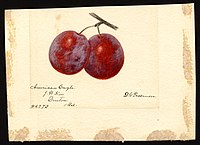 Image of the American Eagle variety of plums (scientific name: Prunus domestica), with this specimen originating in Denton, Caroline County, Maryland, United States
Image of the American Eagle variety of plums (scientific name: Prunus domestica), with this specimen originating in Denton, Caroline County, Maryland, United States -
 Image of the Abundance variety of plums (scientific name: Prunus domestica), with this specimen originating in Fayetteville, Cumberland County, North Carolina, United States
Image of the Abundance variety of plums (scientific name: Prunus domestica), with this specimen originating in Fayetteville, Cumberland County, North Carolina, United States -
 Image of the Sirocco variety of plums (scientific name: Prunus domestica), with this specimen originating in Fayetteville, Cumberland County, North Carolina, United States. (1895)
Image of the Sirocco variety of plums (scientific name: Prunus domestica), with this specimen originating in Fayetteville, Cumberland County, North Carolina, United States. (1895) -
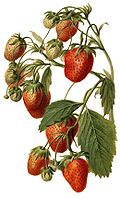 Parker Earle (strawberry) (1890)
Parker Earle (strawberry) (1890) -
 Watercolor of the Wickson Plum (1896)
Watercolor of the Wickson Plum (1896) -
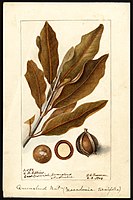 Image of Macadamia (scientific name: Macadamia ternifolia), with this specimen originating in Ipswich, Queensland, Australia. (1904)
Image of Macadamia (scientific name: Macadamia ternifolia), with this specimen originating in Ipswich, Queensland, Australia. (1904) -
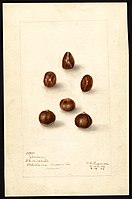 Image of the Korean variety of hazelnuts (scientific name: Corylus), with this specimen originating in Japan (1906)
Image of the Korean variety of hazelnuts (scientific name: Corylus), with this specimen originating in Japan (1906) -
 Image of the Krummels variety of peaches (scientific name: Prunus persica) (1910)
Image of the Krummels variety of peaches (scientific name: Prunus persica) (1910) -
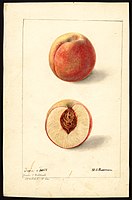 Image of the Dixie variety of peaches (scientific name: Prunus persica), with this specimen originating in Waldo, Alachua County, Florida, United States (1893)
Image of the Dixie variety of peaches (scientific name: Prunus persica), with this specimen originating in Waldo, Alachua County, Florida, United States (1893) -
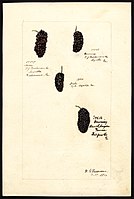 Image of brambles (scientific name: Rubus), with this specimen originating in Augusta, Richmond County, Georgia, United States. (1900)
Image of brambles (scientific name: Rubus), with this specimen originating in Augusta, Richmond County, Georgia, United States. (1900) -
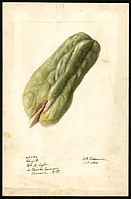 Image of chayote (scientific name: Sechium edule), with this specimen originating in Panama (1910)
Image of chayote (scientific name: Sechium edule), with this specimen originating in Panama (1910) -
 Image of mangosteens (scientific name: Garcinia mangostana), with this specimen originating in Trinidad and Tobago (1909)
Image of mangosteens (scientific name: Garcinia mangostana), with this specimen originating in Trinidad and Tobago (1909) -
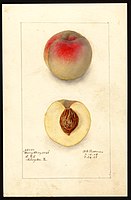 Image of the Dewey Cling variety of peaches (scientific name: Prunus persica), with this specimen originating in Rosslyn, Arlington County, Virginia, United States (1908)
Image of the Dewey Cling variety of peaches (scientific name: Prunus persica), with this specimen originating in Rosslyn, Arlington County, Virginia, United States (1908) -
 Image of the Sea Eagle variety of peaches (scientific name: Prunus persica), with this specimen originating in Amherst, Hampshire County, Massachusetts, United States (1905)
Image of the Sea Eagle variety of peaches (scientific name: Prunus persica), with this specimen originating in Amherst, Hampshire County, Massachusetts, United States (1905) -
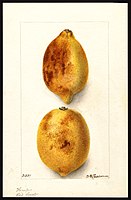 Image of lemons (scientific name: Citrus limon), with this specimen originating in Whittier, Los Angeles County, California, United States. (1904)
Image of lemons (scientific name: Citrus limon), with this specimen originating in Whittier, Los Angeles County, California, United States. (1904) -
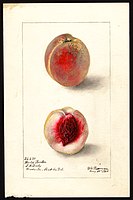 Image of the World Beater variety of peaches (scientific name: Prunus persica), with this specimen originating in Woodside, Kent County, Delaware, United States (1905)
Image of the World Beater variety of peaches (scientific name: Prunus persica), with this specimen originating in Woodside, Kent County, Delaware, United States (1905) -
 Image of the Dewey variety of plums (scientific name: Prunus domestica), with this specimen originating in Hood River, Hood River County, Oregon, United States. (1898)
Image of the Dewey variety of plums (scientific name: Prunus domestica), with this specimen originating in Hood River, Hood River County, Oregon, United States. (1898) -
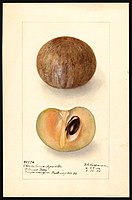 Image of sapodillas (scientific name: Manilkara zapota), with this specimen originating in Miami, Dade County, Florida, United States (1906)
Image of sapodillas (scientific name: Manilkara zapota), with this specimen originating in Miami, Dade County, Florida, United States (1906) -
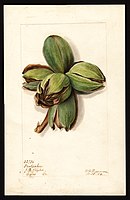 Image of the Frotscher variety of hickory (scientific name: Carya), with this specimen originating in Cairo, Grady County, Georgia, United States (1904)
Image of the Frotscher variety of hickory (scientific name: Carya), with this specimen originating in Cairo, Grady County, Georgia, United States (1904) -
 Image of the Scala variety of loquats (scientific name: Eriobotrya japonica), with this specimen originating in Miami, Dade County, Florida, United States (1909)
Image of the Scala variety of loquats (scientific name: Eriobotrya japonica), with this specimen originating in Miami, Dade County, Florida, United States (1909) -
 Image of the Advance variety of loquats (scientific name: Eriobotrya japonica), with this specimen originating in Orange, Orange County, California, United States. (1900)
Image of the Advance variety of loquats (scientific name: Eriobotrya japonica), with this specimen originating in Orange, Orange County, California, United States. (1900) -
 Image of the Baldwin variety of cherries (scientific name: Prunus avium), with this specimen originating in Seneca, Nemaha County, Kansas, United States (1901)
Image of the Baldwin variety of cherries (scientific name: Prunus avium), with this specimen originating in Seneca, Nemaha County, Kansas, United States (1901) -
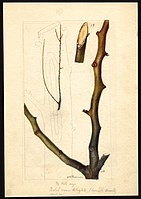 Image of the Flemish Beauty variety of pears (scientific name: Pyrus communis) (1895)
Image of the Flemish Beauty variety of pears (scientific name: Pyrus communis) (1895) -
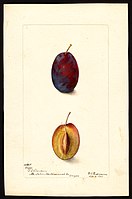 Image of the Sugar variety of plums (scientific name: Prunus domestica), with this specimen originating in Mount Tabor, Portland, Multnomah County, Oregon, United States. (1907)
Image of the Sugar variety of plums (scientific name: Prunus domestica), with this specimen originating in Mount Tabor, Portland, Multnomah County, Oregon, United States. (1907) -
 Image of the Chinese Cling variety of peaches (scientific name: Prunus persica), with this specimen originating in Bentonville, Benton County, Arkansas, United States. (1900)
Image of the Chinese Cling variety of peaches (scientific name: Prunus persica), with this specimen originating in Bentonville, Benton County, Arkansas, United States. (1900) -
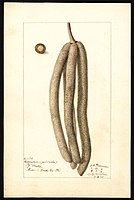 Image (scientific name: Cecropia palmata), with this specimen originating in Miami, Dade County, Florida, United States. (1918)
Image (scientific name: Cecropia palmata), with this specimen originating in Miami, Dade County, Florida, United States. (1918) -
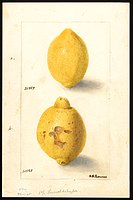 Image of lemons (scientific name: Citrus limon). (1904)
Image of lemons (scientific name: Citrus limon). (1904) -
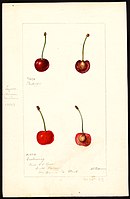 Image of cherries (scientific name: Prunus avium), with this specimen originating in South Haven, Van Buren County, Michigan, United States. (1897)
Image of cherries (scientific name: Prunus avium), with this specimen originating in South Haven, Van Buren County, Michigan, United States. (1897) -
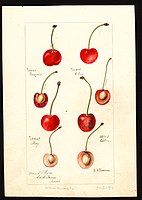 Image of cherries (scientific name: Prunus avium), with this specimen originating in South Haven, Van Buren County, Michigan, United States. (1897)
Image of cherries (scientific name: Prunus avium), with this specimen originating in South Haven, Van Buren County, Michigan, United States. (1897) -
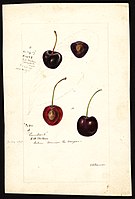 Image of cherries (scientific name: Prunus avium), with this specimen originating in Salem, Marion County, Oregon, United States. (1895)
Image of cherries (scientific name: Prunus avium), with this specimen originating in Salem, Marion County, Oregon, United States. (1895) -
 Image of the Compass variety of plums (scientific name: Prunus domestica), with this specimen originating in Springbrook, Brown County, Minnesota, United States. (1896)
Image of the Compass variety of plums (scientific name: Prunus domestica), with this specimen originating in Springbrook, Brown County, Minnesota, United States. (1896) -
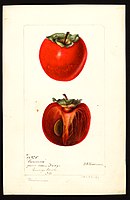 Image of the Lanman variety of persimmons (scientific name: Diospyros), with this specimen originating in Washington, D.C., United States. (1897)
Image of the Lanman variety of persimmons (scientific name: Diospyros), with this specimen originating in Washington, D.C., United States. (1897) -
 Image of the Labrusca variety of grapes (scientific name: Vitis), with this specimen originating in Washington, D.C., United States. (1895)
Image of the Labrusca variety of grapes (scientific name: Vitis), with this specimen originating in Washington, D.C., United States. (1895) -
 Image of the Miller variety of persimmons (scientific name: Diospyros), with this specimen originating in Harlem, Clay County, Missouri, United States. (1907)
Image of the Miller variety of persimmons (scientific name: Diospyros), with this specimen originating in Harlem, Clay County, Missouri, United States. (1907) -
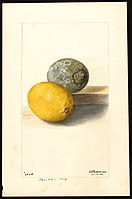 Image of lemons (scientific name: Citrus limon). (1904)
Image of lemons (scientific name: Citrus limon). (1904) -
 Image of the Rastus variety of plums (scientific name: Prunus domestica), with this specimen originating in Denton, Caroline County, Maryland, United States. (1902)
Image of the Rastus variety of plums (scientific name: Prunus domestica), with this specimen originating in Denton, Caroline County, Maryland, United States. (1902) -
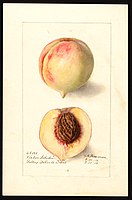 Image of the Victor Labodie variety of peaches (scientific name: Prunus persica), with this specimen originating in Dallas, Dallas County, Texas, United States. (1910)
Image of the Victor Labodie variety of peaches (scientific name: Prunus persica), with this specimen originating in Dallas, Dallas County, Texas, United States. (1910) -
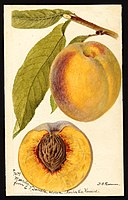 Image of the Marcella variety of peaches (scientific name: Prunus persica), with this specimen originating in Kiowa, Barber County, Kansas, United States. (1894)
Image of the Marcella variety of peaches (scientific name: Prunus persica), with this specimen originating in Kiowa, Barber County, Kansas, United States. (1894) -
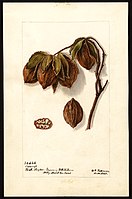 Image of the Swamp variety of hickory (scientific name: Carya), with this specimen originating in Holly, Houston County, Texas, United States. (1903)
Image of the Swamp variety of hickory (scientific name: Carya), with this specimen originating in Holly, Houston County, Texas, United States. (1903) -
 Image of gooseberries (scientific name: Ribes), with this specimen originating in South Haven, Van Buren County, Michigan, United States. (1897)
Image of gooseberries (scientific name: Ribes), with this specimen originating in South Haven, Van Buren County, Michigan, United States. (1897) -
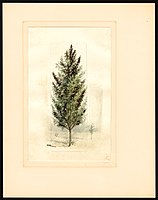 Image of the Kieffer variety of pears (scientific name: Pyrus communis). (1898)
Image of the Kieffer variety of pears (scientific name: Pyrus communis). (1898) -
 Image of the Lanman variety of persimmons (scientific name: Diospyros), with this specimen originating in Washington, D.C., United States. (1898)
Image of the Lanman variety of persimmons (scientific name: Diospyros), with this specimen originating in Washington, D.C., United States. (1898) -
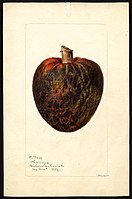 Image of cherimoyas (scientific name: Annona cherimola), with this specimen originating in Key West, Monroe County, Florida, United States.
Image of cherimoyas (scientific name: Annona cherimola), with this specimen originating in Key West, Monroe County, Florida, United States. -
 Image of the Malaga variety of grapes (scientific name: Vitis). (1909)
Image of the Malaga variety of grapes (scientific name: Vitis). (1909) -
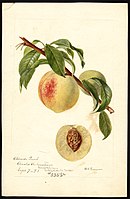 Image of the Chinese variety of peaches (scientific name: Prunus persica), with this specimen originating in Brookline, Norfolk County, Massachusetts, United States. (1893)
Image of the Chinese variety of peaches (scientific name: Prunus persica), with this specimen originating in Brookline, Norfolk County, Massachusetts, United States. (1893) -
 Image of the Silver Cluster variety of grapefruits (scientific name: Citrus paradisi), with this specimen originating in Winter Haven, Polk County, Florida, United States.
Image of the Silver Cluster variety of grapefruits (scientific name: Citrus paradisi), with this specimen originating in Winter Haven, Polk County, Florida, United States. -
 Image of the Ascension variety of plums (scientific name: Prunus domestica), with this specimen originating in Cove, Union County, Oregon, United States. (1900)
Image of the Ascension variety of plums (scientific name: Prunus domestica), with this specimen originating in Cove, Union County, Oregon, United States. (1900) -
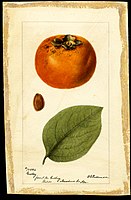 Image of the Godbey variety of persimmons (scientific name: Diospyros), with this specimen originating in Waldo, Alachua County, Florida, United States.
Image of the Godbey variety of persimmons (scientific name: Diospyros), with this specimen originating in Waldo, Alachua County, Florida, United States. -
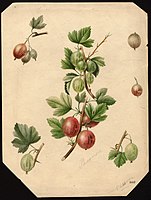 Image of gooseberries (scientific name: Ribes).
Image of gooseberries (scientific name: Ribes). -
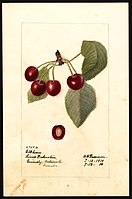 Image of the Elkhorn variety of cherries (scientific name: Prunus avium), with this specimen originating in Grimsby, Ontario, Canada. (1910)
Image of the Elkhorn variety of cherries (scientific name: Prunus avium), with this specimen originating in Grimsby, Ontario, Canada. (1910) -
 Image of the Axtill variety of persimmons (scientific name: Diospyros), with this specimen originating in Liberty County, Georgia, United States. (1900)
Image of the Axtill variety of persimmons (scientific name: Diospyros), with this specimen originating in Liberty County, Georgia, United States. (1900) -
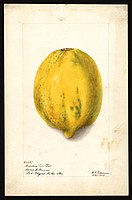 Image of papayas (scientific name: Carica papaya), with this specimen originating in Fort Myers, Lee County, Florida, United States. (1903)
Image of papayas (scientific name: Carica papaya), with this specimen originating in Fort Myers, Lee County, Florida, United States. (1903) -
 Image of the Madison variety of plums (scientific name: Prunus domestica), with this specimen originating in York, York County, Pennsylvania, United States. (1894)
Image of the Madison variety of plums (scientific name: Prunus domestica), with this specimen originating in York, York County, Pennsylvania, United States. (1894) -
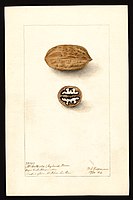 Image of the McCallister variety of pecans (scientific name: Carya illinoinensis), with this specimen originating in Washington, Wilkes County, Georgia, United States. (1904)
Image of the McCallister variety of pecans (scientific name: Carya illinoinensis), with this specimen originating in Washington, Wilkes County, Georgia, United States. (1904) -
 Image of apples (scientific name: Malus domestica). (1903)
Image of apples (scientific name: Malus domestica). (1903) -
 Image of the Chasselas Dore variety of grapes (scientific name: Vitis).
Image of the Chasselas Dore variety of grapes (scientific name: Vitis). -
 Image of the Golden Beauty variety of cherries (scientific name: Prunus avium), with this specimen originating in South Haven, Van Buren County, Michigan, United States. (1894)
Image of the Golden Beauty variety of cherries (scientific name: Prunus avium), with this specimen originating in South Haven, Van Buren County, Michigan, United States. (1894) -
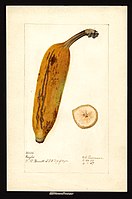 Image of the Ingles variety of bananas (scientific name: Musa), with this specimen originating in Puerto Rico, United States. (1907)
Image of the Ingles variety of bananas (scientific name: Musa), with this specimen originating in Puerto Rico, United States. (1907) -
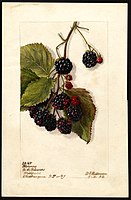 Image of the Blowers variety of blackberries (scientific name: Rubus subg. Rubus Watson), with this specimen originating in Westfield, Chautauqua County, New York, United States. (1904)
Image of the Blowers variety of blackberries (scientific name: Rubus subg. Rubus Watson), with this specimen originating in Westfield, Chautauqua County, New York, United States. (1904) -
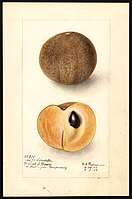 Image of the No. 7 variety of sapodillas (scientific name: Manilkara zapota), with this specimen originating in Miami, Dade County, Florida, United States. (1906)
Image of the No. 7 variety of sapodillas (scientific name: Manilkara zapota), with this specimen originating in Miami, Dade County, Florida, United States. (1906) -
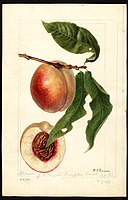 Image of the Nysson variety of peaches (scientific name: Prunus persica), with this specimen originating in Douglas, Allegan County, Michigan, United States. (1893)
Image of the Nysson variety of peaches (scientific name: Prunus persica), with this specimen originating in Douglas, Allegan County, Michigan, United States. (1893) -
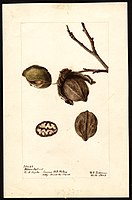 Image of the Wilson Hybrid variety of hickory (scientific name: Carya), with this specimen originating in Hetty, Hunt County, Texas, United States. (1903)
Image of the Wilson Hybrid variety of hickory (scientific name: Carya), with this specimen originating in Hetty, Hunt County, Texas, United States. (1903) -
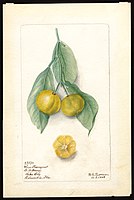 Image of the Sour variety of kumquats (scientific name: Fortunella), with this specimen originating in Lake City, Columbia County, Florida, United States. (1902)
Image of the Sour variety of kumquats (scientific name: Fortunella), with this specimen originating in Lake City, Columbia County, Florida, United States. (1902) -
 Image of the Premier variety of loquats (scientific name: Eriobotrya japonica), with this specimen originating in Orange, Orange County, California, United States. (1903)
Image of the Premier variety of loquats (scientific name: Eriobotrya japonica), with this specimen originating in Orange, Orange County, California, United States. (1903) -
 Image of sapodillas (scientific name: Manilkara zapota), with this specimen originating in Key West, Monroe County, Florida, United States. (1899)
Image of sapodillas (scientific name: Manilkara zapota), with this specimen originating in Key West, Monroe County, Florida, United States. (1899) -
 Image of the Howell variety of pears (scientific name: Pyrus communis), with this specimen originating in Still Pond, Kent County, Maryland, United States. (1895)
Image of the Howell variety of pears (scientific name: Pyrus communis), with this specimen originating in Still Pond, Kent County, Maryland, United States. (1895) -
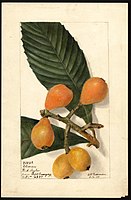 Image of the Oliver variety of loquats (scientific name: Eriobotrya japonica). (1905)
Image of the Oliver variety of loquats (scientific name: Eriobotrya japonica). (1905) -
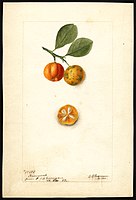 Image of kumquats (scientific name: Fortunella), with this specimen originating in Saint Leo, Pasco County, Florida, United States. (1900)
Image of kumquats (scientific name: Fortunella), with this specimen originating in Saint Leo, Pasco County, Florida, United States. (1900) -
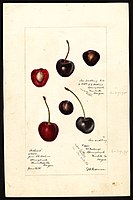 Image of cherries (scientific name: Prunus avium), with this specimen originating in Springbrook, Yamhill County, Oregon, United States. (1895)
Image of cherries (scientific name: Prunus avium), with this specimen originating in Springbrook, Yamhill County, Oregon, United States. (1895) -
 Image of the Steptoe variety of plums (scientific name: Prunus domestica), with this specimen originating in Colfax, Whitman County, Washington, United States. (1894)
Image of the Steptoe variety of plums (scientific name: Prunus domestica), with this specimen originating in Colfax, Whitman County, Washington, United States. (1894) -
 Image of nutmeg (scientific name: Myristica fragrans), with this specimen originating in Puerto Rico, United States. (1906)
Image of nutmeg (scientific name: Myristica fragrans), with this specimen originating in Puerto Rico, United States. (1906) -
 Image of the Reward variety of brambles (scientific name: Rubus), with this specimen originating in Washington, D.C., United States. (1901)
Image of the Reward variety of brambles (scientific name: Rubus), with this specimen originating in Washington, D.C., United States. (1901) -
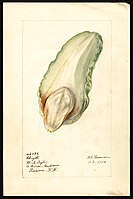 Image of chayote (scientific name: Sechium edule), with this specimen originating in Panama. (1910)
Image of chayote (scientific name: Sechium edule), with this specimen originating in Panama. (1910) -
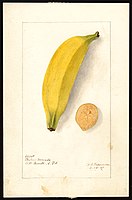 Image of the Platano Morado variety of bananas (scientific name: Musa). (1907)
Image of the Platano Morado variety of bananas (scientific name: Musa). (1907) -
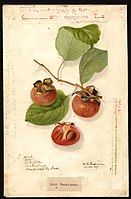 Image of the Ruby variety of persimmons (scientific name: Diospyros), with this specimen originating in Cartersburg, Hendricks County, Indiana, United States. (1905)
Image of the Ruby variety of persimmons (scientific name: Diospyros), with this specimen originating in Cartersburg, Hendricks County, Indiana, United States. (1905) -
 Image of the Peento variety of peaches (scientific name: Prunus persica), with this specimen originating in Washington, D.C., United States. (1902)
Image of the Peento variety of peaches (scientific name: Prunus persica), with this specimen originating in Washington, D.C., United States. (1902) -
 Image of lemons (scientific name: Citrus limon), with this specimen originating in Whittier, Los Angeles County, California, United States. (1904)
Image of lemons (scientific name: Citrus limon), with this specimen originating in Whittier, Los Angeles County, California, United States. (1904) -
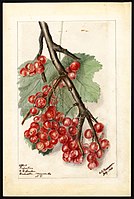 Image of the Perfection variety of gooseberries (scientific name: Ribes), with this specimen originating in Rochester, Monroe County, New York, United States. (1903)
Image of the Perfection variety of gooseberries (scientific name: Ribes), with this specimen originating in Rochester, Monroe County, New York, United States. (1903) -
 Image of the Triumph variety of peaches (scientific name: Prunus persica), with this specimen originating in Vineyard, Spalding County, Georgia, United States. (1895)
Image of the Triumph variety of peaches (scientific name: Prunus persica), with this specimen originating in Vineyard, Spalding County, Georgia, United States. (1895) -
 Image of plums (scientific name: Prunus domestica), with this specimen originating in Geneva, Allen County, Kansas, United States. (1898)
Image of plums (scientific name: Prunus domestica), with this specimen originating in Geneva, Allen County, Kansas, United States. (1898)
Referencias
- ↑ a b c Fusonie, Alan E. (1990). «The Heritage of Original Art and Photo Imaging in USDA: Past, Present and Future». Agricultural History 64 (2): 300-314. ISSN 0002-1482. Consultado el 22 de abril de 2020.
- ↑ a b c Harrison, Carrie (octubre, 2001). «Flowers in Water Color, 1911» (PDF) (en inglés). Consultado el 25 de abril de 2020. «Transcript of an anonymous, typewritten biography appearing in the preface pages of the Deborah G. Passmore volume».
- ↑ «Deborah Griscom Passmore (d. 1911)». www.christies.com (en inglés). Consultado el 31 de mayo de 2019.
- ↑ Cope, Gilbert; Fishwick, Henry; Chester, Joseph Lemuel (1887). Genealogy of the Sharpless family, descended from John and Jane Sharples, settlers near Chester, Pennsylvania, 1682, together with some account of the English ancestry of the family, including the researches by Henry Fishwick, P.H.S., and the late Joseph Lemuel Chester;and a full report of the bi-centennial reunion of 1882. Philadelphia, For the family, under the auspices of the Bi-centennial committee. Consultado el 25 de abril de 2020. «Deborah Passmore Gillingham's mother, Hannah Passmore, was a younger sister of Deborah Griscom Passmore's father. Duncan (2010) incorrectly lists Deborah Passmore Gillingham's mother's name as Deborah instead of Hannah.»
- ↑ Duncan, John (2010). Lilies and Magnolias: Botanical Watercolors of Deborah Passmore Gillingham (en inglés). Schiffer Publishing, Limited. ISBN 978-0-7643-3441-2. Consultado el 25 de abril de 2020.
- ↑ a b c White, James J., and Erik A. Neumann (1982). The Collection of Pomological Watercolors at the U.S. National Arboretum". Huntia: A Journal of Botanical History 4:2. p. 106-107.
- ↑ «Deborah Griscom Passmore Watercolors | Special Collections». specialcollections.nal.usda.gov. Consultado el 25 de abril de 2020.
- ↑ Gaard, Greta (17 de junio de 2010). Ecological Politics (en inglés). Temple University Press. ISBN 978-1-4399-0398-8. Consultado el 25 de abril de 2020.
Otras lecturas
- Britton, Nathaniel Lord y Joseph Nelson Rose. Las Cactaceae . Conjunto de 4 volúmenes. Washington, DC: The Carnegie Institution, 1919–23.
Enlaces externos
- Colección de acuarela pomológica del USDA
- Ilustraciones de cactus en el Museo Nacional de Historia Natural
 Datos: Q17421698
Datos: Q17421698 Multimedia: Deborah Griscom Passmore / Q17421698
Multimedia: Deborah Griscom Passmore / Q17421698



























































































